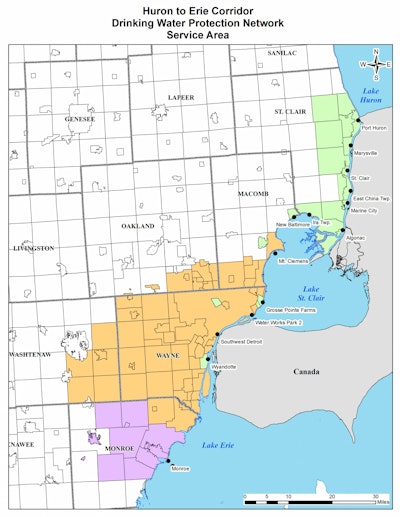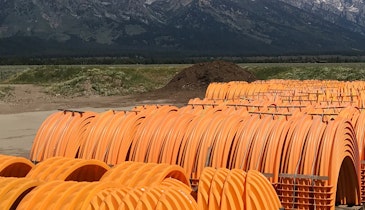
Interested in Infrastructure?
Get Infrastructure articles, news and videos right in your inbox! Sign up now.
Infrastructure + Get AlertsOver four million people living in waterfront communities in southeastern Michigan’s St. Clair, Macomb and Wayne counties trust in the safety of their drinking water. And with good reason.
In 2006, Federal funding enabled the creation of the $3.5 million Huron-to-Erie Drinking Water Monitoring System for 14 water treatment plants drawing drinking water from the St. Clair River, Lake St. Clair, Detroit River and Lake Erie. The system provided a critical safeguard to detect water quality threats, including chemical spills from upstream industrial plants.
An engineering study determined which communities would be included and what system each would get – basic, mid-level or advanced – based on susceptibility to contamination from the north, or Canadian, end of the system.
According to Mark Scott, water department superintendent for Algonac, one of the communities in the monitoring district, monitoring equipment was installed at the intake site to detect water temperature changes, conductivity, turbidity, pH, other water quality indicators and chemicals or other contaminants.
Monitoring equipment parameters
When the system was first implemented, equipment installed for coalition communities included:
• Multiparameter Probe (Basic site) provides a general measure of pollution indicating the presence of oxygen demanding, caustic/acidic, water soluble and water insoluble compounds, chemical reactions, and algal growth. Specifically it monitors dissolved oxygen, specific conductance, pH, temperature, turbidity, oxidation reduction potential and chlorophyll concentrations.
• TOC Analyzer (Mid-level site) provides a general measure of organic compounds. This is important because organic compounds may react with water treatment disinfectants to produce potentially toxic and carcinogenic compounds. The unit measures total organic carbon concentrations in parts per million.
• Fluorometer (Mid-level site) provides a general measure of petroleum products. The Huron-to-Erie units are calibrated to measure diesel fuel in parts per million.
• Gas Chromatography/Mass Spectrometry – GC/MS (Advanced site) measures the concentration of specific volatile organic compounds in parts per billion. The Huron-to-Erie units were calibrated to measure benzene, toluene, xylenes, MTBE, chloroform, hexane, carbon tetrachloride, cyclohexane, tetrachloroethene, trichloroethene, trichloroethane, acrylonitrile, styrene, dichloroethane, dichloropropane, vinyl chloride, methylene chloride, ethyl benzene, chlorobenzene, dichlorobenzene, and ethylene dibromide.
Monitoring devices sent data every 15 minutes, around-the-clock, to a Web-based alert system. When issues were detected above or below desired parameters, alerts were generated, going to the plant where the problem was detected, as well as to all other downstream plants so they could take appropriate action.
| Multiparameter Probe | TOC Analyzer | Fluorometer | ||||
| Routine | Non-routine | Routine | Non-routine | Routine | Non-routine | |
| Labor (contractor) | $3,348 | $2,130 | $1,496 | $497 | $1,000 | $497 |
| Expenses | $2,356 | $2,489 | $8,000 | $00 | $602 | $550 |
| Subtotal | $5,704 | $4,619 | $9,496 | $497 | $1,602 | $1,047 |
| Total | $10,323 | $9,993 | $2,649 | |||
| Data Logger | Multiparameter Probe-2 | TOC Analyzer | Fluorometer | |
| Cost-1 | $3,000 | $6,200 | $23,000 | $24,000 |
| Useful Life | 7-10 yrs | 6 yrs | 8-10 yrs | 10+ yrs |
Funding runs out
“When grant money was available, the program ran quite smoothly,” says Bari Wrubel, water system supervisor for Marysville, one of the communities participating in the monitoring system, and chairperson of the water quality district. “But when funding ran out, every community in the system was challenged to find the money to keep their equipment running.”
The grant covered the annual monitoring fee charged by the firm that provided the data collection, real-time reporting and alerts, annual calibration and maintenance, parts and component replacement.
An early proposal to base fees on the amount of water communities use made the cost prohibitive for a municipality like Detroit with its large population. Others dropped out due to dissatisfaction with data inconsistency or data processing problems, budgetary constraints, or because they were comfortable doing their own monitoring without being part of the network.
Taking out cost
More recently, the coalition has been working long and hard with member communities and local officials to find a way to make the system affordable for all that want to participate. The almost $1 million total annual cost estimate was reduced dramatically. Negotiations with the data monitoring firm resulted in the Web-based data logging and alert system fee being reduced several thousand dollars to a flat fee of $1,950 per community. Participating communities have to commit to budgeting $10,000 a year for equipment calibration, as well as replacement parts and, eventually, replacement of the monitoring devices themselves.
“It’s possible to get monitoring costs even lower by training staff to calibrate the equipment,” says Wrubel, who helped Marysville avoid the $6,000 to $7,000 annual fee charged by engineering firms by getting trained to do it themselves. The Marysville Water Department also does their own calibration and dilutes testing chemicals themselves in order to buy the less expensive, undiluted ones, Wrubel adds. Other communities, such as Algonac, are planning similar cost-saving measures, according to Scott.
“Each community was able to decide what equipment they wanted to keep online,” continues Wrubel. “When communities could not afford continuous operation of a GC/MS, they were taken offline. We are working to determine what will be the most effective usage for the GC/MS equipment.” One option, he says, is to employ it as a portable device to be used following a spill emergency once the original indicating triggers have been alerted from the online equipment.
Whenever possible, individual water districts are sharing parts from monitoring components removed by those communities no longer part of the district. Eventually this supply will be depleted, and communities will begin purchasing replacement equipment from their own budgets.
Rebuilding the coalition
Today, the Huron-to-Erie Drinking Water Monitoring System consists of eight communities: Marysville, Marine City, Algonac, Ira Township, Mt. Clemens, Detroit, Wyandotte and Monroe. While some, such as Port Huron, New Baltimore, East China Township, St. Clair, and Grosse Pointe Farms, have decided to remove their equipment completely, others are slowly coming back or considering coming back on board.
Algonac, which was part of the district until 2010, recently voted to rejoin the monitoring system when neighboring Clay Township decided to participate with them. “Clay Township has a larger population and greater water usage, so will pay a larger portion of the cost,” Scott says. “Cost sharing made it affordable for both of us.”
According to Wrubel, the coalition is working more effectively than ever before to solve issues. He points to the barge that sank in St. Clair Lake this past summer as one such example. “Here at Marysville, we only had the multiparameter probe,” he says. “After that incident, we looked into using a fluorometer that was removed from another site. Because our in-house calibrations and maintenance were saving us money, we were able to afford to install and maintain our own fluorometer to protect us from future events.”
In July 2011, Port Huron was still on the system when their online probe saw a pH drop to 4 from 8.2 with turbidity detected. “The monitoring system enabled them to react immediately,” Wrubel continues. “They were able to shut down their intake before the water made it all the way into the plant. Even more importantly, the system alerted others downstream to watch and possibly shut down their intake.
“At Marysville, we reacted to the alert from Port Huron and decided to shut down our plant, monitoring the river water until we saw the pH drop come and go through the river. Once the pH returned to normal, we were able to produce water again.”
Clearly, there’s more work ahead to ensure the best possible safeguards are in place and communities in the region are assured of quality drinking water. Continued regional cooperation will be key to the growth and success of the Huron-to-Erie Drinking Water Monitoring System.
1-2007 Pricing
2-The individual sensors are expendable and included in annual maintenance cost
(Charts provided by Mark Scott, Algonac Water Treatment Department)






